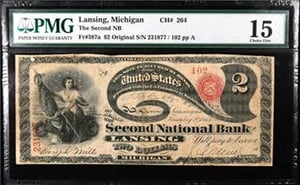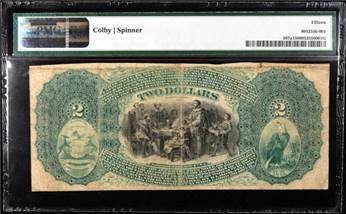The Only Known Surviving US $2.00 “Lazy Deuce” Note Issued for a Lansing, Michigan Bank

What Were National Bank Notes?
Prior to the Civil War, the US government did not issue paper money. Instead, some states, cities, private banks, and other companies issued notes that were theoretically redeemable in specie (gold or silver). Oversight of these issuers was often lax and there were several fraudulent issues.
The US government began to issue a variety of banknotes after the start of the Civil War to help finance government debt which, at the time, was primarily the costs of the War. In 1863, the National Banking Act established a system of National Banks which could issue National Bank Notes under federal supervision. In 1864, a 2% excise tax was imposed on all other non-federal currency issues to discourage such issues from competing with those of the federal government (this tax was raised to 10% in 1865 and later to 20% to effectively bring an end to non-federal paper money).
From 1863 to 1935, National Bank Notes were issued by banks throughout the states and US territories. Federally-chartered National Banks could purchase US government bonds (which provided cash flow to the US government), then deposit those bonds as collateral with the US Treasury. The Treasury would then issue Bank Notes for each bank up to 90% of the amount of bonds held by the US Treasury. This effectively monetized part of the US government’s debt.
Other than some of the earliest issues such as with the note pictured above, each National Bank Note bore the issuing bank’s national charter number. Each National Bank Note also prominently displayed the name, city, and state or territory of the bank (in lieu of “United States of America”). Each Note featured two serial numbers, one for the US Treasury and one for the individual bank. Each note also bore four signatures. For most of the National Bank Note-issuing era, the signatures of the Register of the US and the Treasurer of the US were printed on the notes. Then there were two signatures of officials of the specific bank, usually the president and the cashier. On early National Bank Notes, local bank signatures were written by hand; later these were printed.
As with other US paper money issues up into the early 20th Century, National Bank Notes featured elaborate and intricate artwork. The $2.00 Lazy Deuce, for example, features a vignette of “Stars and Stripes” on the left of the front with a large horizontal “2” to the right (hence the nickname “Lazy Deuce”). The central design on the back portrays “Sir Walter Raleigh Presenting Corn and Tobacco to the English.” Early National Bank Notes also feature artwork at the left of the reverse that is similar to the state or territorial seal where the bank was located, such as for Michigan on this Note.

The Second National Bank Of Lansing, Michigan
The Second National Bank of Lansing, Michigan traces its origins back to an exchange office opened in 1850 by Joseph C. Bailey. In 1862, Bailey partnered with Charles S. Hunt to convert the company to a bank, named J. C. Bailey & Co. On February 4, 1864, their bank was chartered as The First National Bank of Lansing (federal charter #232). The First National Bank of Lansing never went into operation and was sold to The Second National Bank of Lansing (federal charter #264) on December 4, 1864. The Second National Bank of Lansing had received its federal charter on February 18, 1864 with a capital stock of $50,000. Its first officers were James I. Mead, president, Hiram H. Smith, vice president (who was also Lansing’s first mayor in 1859), and Joseph Mills, cashier.
Over time, bank officers changed. Federal bank charters were for 20 years, which could be renewed. The Bank gave up its federal charter on July 31, 1884 to convert back to a private bank named Longyear’s Bank, under the presidency of Ephraim Longyear. Longyear’s Bank converted back to a federal charter in 1886 with the name City National Bank of Lansing (federal charter #3513).
During its history, the Second National Bank of Lansing issued the following National Bank Notes:
First Charter Original Series $1.00 4,800 notes
First Charter Original Series $2.00 1,600 notes
First Charter Original Series $5.00 21,000 notes
First Charter Original Series $50.00 100 notes
First Charter Original Series $100.00 100 notes
Of these notes, first issued in early 1865, there are three known surviving specimens—2 of the $1.00 Notes and the $2.00 Note just acquired by Liberty Coin Service and pictured here. One of the $1.00 Notes was issued in 1873-1875 as it has the signatures of Hiram H. Smith as then Bank president and Ephraim Longyear as Bank cashier. The other $1.00 and the $2.00 Note were almost certainly placed into circulation during the Civil War.
Later, the Second National Bank of Lansing issued the following National Bank Notes:
First Charter Series of 1875 $1.00 230 notes
First Charter Series of 1875 $2.00 230 notes
First Charter Series of 1875 $5.00 2,000 notes
First Charter Series of 1875 $50.00 250 notes
First Charter Series of 1875 $100.00 250 notes
Of these latter issues, only two surviving specimens are known—a $1.00 and a $5.00 National Bank Note.
Thus, the $2.00 National Bank Note is the only known surviving specimen of that denomination from the Second National Bank of Lansing. None of the other National Banks from Lansing that issued notes issued any $2.00 National Bank Notes.
By the way, any $2.00 Lazy Deuce National Bank Notes are prized rarities. In a 2006 census, only 37 known surviving Lazy Deuces were known for all Michigan National Banks combined.
Other Lansing National Banks That Issued US Paper Money
US National Bank Notes were issued for four other Lansing, Michigan Banks.
Lansing National Bank held federal charter #1953. It operated under this name from 1872 to 1892. Upon the expiration of its charter it converted to a state bank under various names and survives today as part of PNC Bank. Lansing National Bank issued 19,424 National Bank Notes with only 1 known surviving specimen.
City National Bank held federal charter # 3513. It was federally chartered in 1886 upon conversion from Longyear’s Bank, which in 1884 became a state bank after its federal charter as the Second National Bank expired. It’s first president was Edward W. Sparrow, namesake of a Lansing hospital. The bank failed in the Great Depression and was liquidated in 1931. Its assets were sold to Capital National Bank. City National Bank issued 545,374 National Bank Notes, with perhaps 100 known surviving examples.
Capital National Bank held federal charter #8148. It was organized in 1906, with Oldsmobile founder Ransom Eli Olds as its driving force. Olds served as president from 1906 to 1931, then as chairman of the board from 1931 until it closed in 1934. The appearance of Olds’ signature on these notes make them popular with numismatic and automotive history collectors. This bank also failed during the Great Depression, being placed into conservatorship in 1933 and then receivership in 1934. Some assets and virtually all personnel were taken over by Lansing National Bank. Capital National Bank issued 517,355 National Bank Notes with almost 200 known surviving specimens.
Lansing National Bank (using the same name as the bank that gave up its federal charter in 1892) held federal charter #14032. It was one of the last of the 14,320 banks to receive a federal charter under this law. It was federally chartered in February, 1934 and placed into receivership (another Great Depression failure) on March 13, 1934. In 1941, the Bank was consolidated with five failed National Banks around Michigan to create Michigan National Bank which, after multiple mergers, is today part of Bank of America. Lansing National Bank issued 19,996 National Bank Notes of which there are at least 24 known survivors.
The Popularity Of Collecting National Bank Notes
US National Bank Notes were issued for thousands of cities and towns across the country. The local bank officers who signed them were often the “Who’s Who” of the city’s or town’s history. Just in Michigan, for example, National Bank Notes were issued for 280 Banks in about 140 cities and towns. Collectors enjoy owning a piece of history from their hometowns or other places that have significance to them or collecting issues from an entire state or region.
Since 1971, Liberty Coin Service has helped collectors, beginning to advanced, enjoy the hunt for their favorite National Bank Notes, especially those from Lansing, Michigan. Your inquiries are welcome.












